Do you have a question about the Hangar 9 fokker D.VII and is the answer not in the manual?
Key specifications including dimensions, weight, and power requirements for the Fokker D.VII.
Guidance on how to understand and follow the assembly manual instructions.
List of tools and adhesives needed for building the model aircraft.
Specifications for radio control system and power components for the aircraft.
Available colors for the model's covering material.
Recommended radio brands and models for optimal performance.
Recommended engine configurations for 2-stroke, 4-stroke, and electric power systems.
Pre-assembly checks and preparation steps for model aircraft parts.
Information about the FS One flight simulator software.
Guidelines for proper disposal of electronic waste in the EU.
Details on the product warranty coverage and limitations.
Manufacturer's liability limitations regarding product use and damages.
Essential safety guidelines for operating the hobby product.
List of all parts included in the aircraft kit.
List of additional items that can be purchased separately.
List of parts, tools, and adhesives for radio installation.
Procedures for mounting servos and receiver, and connecting extensions.
Mounting procedure for a 2.4GHz remote receiver and antenna placement.
Cutting opening and mounting the switch to the fuselage side.
List of parts, tools, and adhesives for aileron servo installation.
Preparing and gluing servo mounting blocks to the hatch.
Marking and drilling screw locations for servo mounting.
Mounting the aileron servo to the blocks with screws.
Modifying servo horn and connecting servo extension.
Routing the servo extension through the wing and preparing exit point.
Securing the servo hatch and connecting pushrods to control horns.
Bending and connecting pushrods to servo arms.
Repeating the installation process for the other aileron servo.
List of parts, tools, and adhesives for wing panel joining.
Marking and fitting wing spars into the panels.
Applying epoxy to joiner and spar pockets for panel bonding.
Joining the wing panels and ensuring a tight fit.
Applying epoxy to wing ribs and joining panels.
Applying a covering strip to reinforce the wing joint.
List of components and tools for wing installation.
Installing forward and rear wing cabane struts to the fuselage.
Routing servo leads and attaching N-struts to the top wing.
Exposing blind nuts for securing the top wing.
Installing the wing tube, bottom wing panels, and N-struts.
List of parts, tools, and adhesives for tail installation.
Fitting, marking, trimming, and gluing the vertical fin to the stabilizer.
Positioning stabilizer, tracing fuselage, trimming, and applying epoxy.
Applying epoxy to fuselage saddle and attaching the stabilizer.
List of parts, tools, and adhesives for linkage installation.
Routing, marking, bending, and connecting the rudder pushrod.
Securing rudder pushrod and installing elevator pushrod and clevis.
List of parts and tools for landing gear installation.
Fitting the tail skid and positioning the main landing gear legs.
Attaching gear legs to fuselage and securing the spreader wing.
Sliding axle, placing O-rings, and creating a flat spot for wheel collar.
Installing wheel backplate, collar, and rebuilding the wheel.
List of components and tools for 4-stroke engine installation.
Positioning template, drilling, and installing blind nuts and engine mount.
Verifying throttle arm, marking pushrod hole, and positioning engine.
Mounting throttle servo and securing pushrod connector.
Centering servo, securing pushrod, and mounting receiver battery.
Securing fuel tank, attaching muffler, and mounting weight box.
List of components and tools for 2-stroke engine installation.
Positioning template, drilling, and installing blind nuts and engine mount.
Marking pushrod hole, positioning engine, and reinforcing servo holes.
Mounting throttle servo and securing pushrod connector.
Securing pushrod, mounting battery, and installing fuel tank.
Mounting weight box and attaching muffler and fuel lines.
List of components and tools for electric motor installation.
Positioning template, drilling, and mounting motor to firewall.
Attaching motor, weight box, and mounting the electronic speed control.
Attaching battery to tray and securing the tray in the fuselage.
List of components and tools for cowling and cockpit installation.
Marking cowl mounting, trimming engine, and attaching exhaust and engine.
Installing baffles and drilling mounting holes in the cowling.
Fastening the cowling to the fuselage with screws.
Cutting openings for air exit and needle valve adjustment.
Attaching propeller, pilot, and optional cockpit cover hole.
Sanding paint on cockpit cover for machine gun attachment.
Gluing machine guns and installing the cockpit cover.
Recommended throw amounts and expo settings for ailerons and elevators.
Recommended throw amounts and expo settings for the rudder.
Identifying and marking the recommended Center of Gravity point on the wing.
Procedures for balancing the model using a stand or fingertips.
Final checks of radio installation, control surfaces, and engine.
Steps for engine break-in, field adjustment, and ensuring reliable operation.
Procedure for checking the radio system's operational range before flying.
Important safety guidelines, precautions, and warnings for operating the model.
General rules and definitions for model aircraft operation.
Specific safety rules pertaining to radio-controlled model aircraft.
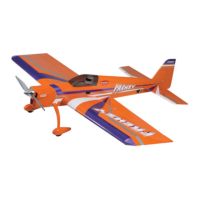
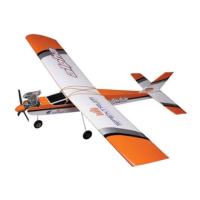
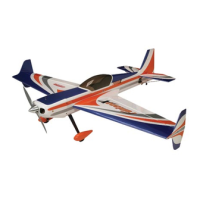
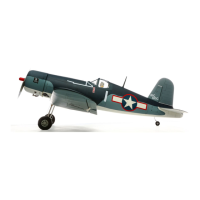
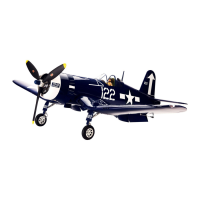
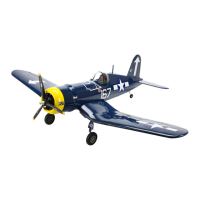
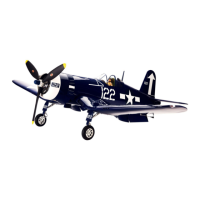

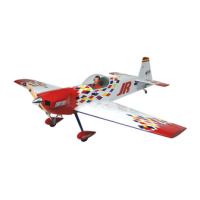
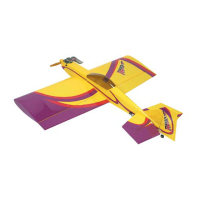
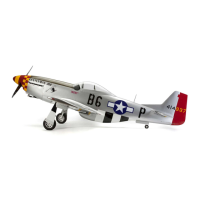
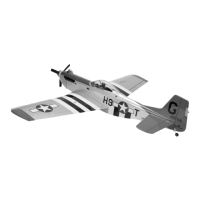
